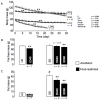The grey mouse lemur uses season-dependent fat or protein sparing strategies to face chronic food restriction
- PMID: 20098678
- PMCID: PMC2809095
- DOI: 10.1371/journal.pone.0008823
The grey mouse lemur uses season-dependent fat or protein sparing strategies to face chronic food restriction
Abstract
During moderate calorie restriction (CR) the heterotherm Microcebus murinus is able to maintain a stable energy balance whatever the season, even if only wintering animals enter into torpor. To understand its energy saving strategies to respond to food shortages, we assessed protein and energy metabolisms associated with wintering torpor expression or summering torpor avoidance. We investigated body composition, whole body protein turnover, and daily energy expenditure (DEE), during a graded (40 and 80%) 35-day CR in short-days (winter; SD40 and SD80, respectively) and long-days (summer; LD40 and LD80, respectively) acclimated animals. LD40 animals showed no change in fat mass (FM) but a 12% fat free mass (FFM) reduction. Protein balance being positive after CR, the FFM loss was early and rapid. The 25% DEE reduction, in LD40 group was mainly explained by FFM changes. LD80 animals showed a steady body mass loss and were excluded from the CR trial at day 22, reaching a survival-threatened body mass. No data were available for this group. SD40 animals significantly decreased their FM level by 21%, but maintained FFM. Protein sparing was achieved through a 35 and 39% decrease in protein synthesis and catabolism (protein turnover), respectively, overall maintaining nitrogen balance. The 21% reduction in energy requirement was explained by the 30% nitrogen flux drop but also by torpor as DEE FFM-adjusted remained 13% lower compared to ad-libitum. SD80 animals were unable to maintain energy and nitrogen balances, losing both FM and FFM. Thus summering mouse lemurs equilibrate energy balance by a rapid loss of active metabolic mass without using torpor, whereas wintering animals spare protein and energy through increased torpor expression. Both strategies have direct fitness implication: 1) to maintain activities at a lower body size during the mating season and 2) to preserve an optimal wintering muscle mass and function.
Conflict of interest statement
Figures





Similar articles
-
Dietary palmitate and linoleate oxidations, oxidative stress, and DNA damage differ according to season in mouse lemurs exposed to a chronic food deprivation.Am J Physiol Regul Integr Comp Physiol. 2009 Oct;297(4):R950-9. doi: 10.1152/ajpregu.00214.2009. Epub 2009 Jul 22. Am J Physiol Regul Integr Comp Physiol. 2009. PMID: 19625694
-
Daily energy expenditure of the grey mouse lemur (Microcebus murinus): a small primate that uses torpor.J Comp Physiol B. 2000 Dec;170(8):633-41. doi: 10.1007/s003600000146. J Comp Physiol B. 2000. PMID: 11192269
-
Chronic food shortage and seasonal modulations of daily torpor and locomotor activity in the grey mouse lemur (Microcebus murinus).Am J Physiol Regul Integr Comp Physiol. 2008 Jun;294(6):R1958-67. doi: 10.1152/ajpregu.00794.2007. Epub 2008 Apr 23. Am J Physiol Regul Integr Comp Physiol. 2008. PMID: 18434438
-
Does Calorie Restriction in Primates Increase Lifespan? Revisiting Studies on Macaques (Macaca mulatta) and Mouse Lemurs (Microcebus murinus).Bioessays. 2018 Oct;40(10):e1800111. doi: 10.1002/bies.201800111. Epub 2018 Aug 1. Bioessays. 2018. PMID: 30067295 Review.
-
Potential effects of fat mass and fat-free mass on energy intake in different states of energy balance.Eur J Clin Nutr. 2018 May;72(5):698-709. doi: 10.1038/s41430-018-0146-6. Epub 2018 May 10. Eur J Clin Nutr. 2018. PMID: 29748653 Review.
Cited by
-
Chronic caloric restriction preserves mitochondrial function in senescence without increasing mitochondrial biogenesis.Cell Metab. 2012 Dec 5;16(6):777-88. doi: 10.1016/j.cmet.2012.11.003. Cell Metab. 2012. PMID: 23217257 Free PMC article.
-
Modulation of Gene Expression in Key Survival Pathways During Daily Torpor in the Gray Mouse Lemur, Microcebus murinus.Genomics Proteomics Bioinformatics. 2015 Apr;13(2):111-8. doi: 10.1016/j.gpb.2015.03.001. Epub 2015 Jun 17. Genomics Proteomics Bioinformatics. 2015. PMID: 26093281 Free PMC article.
-
Cognitive performances are selectively enhanced during chronic caloric restriction or resveratrol supplementation in a primate.PLoS One. 2011 Jan 31;6(1):e16581. doi: 10.1371/journal.pone.0016581. PLoS One. 2011. PMID: 21304942 Free PMC article.
-
Expression profiling and structural characterization of microRNAs in adipose tissues of hibernating ground squirrels.Genomics Proteomics Bioinformatics. 2014 Dec;12(6):284-91. doi: 10.1016/j.gpb.2014.08.003. Epub 2014 Dec 16. Genomics Proteomics Bioinformatics. 2014. PMID: 25526980 Free PMC article.
-
Reproductive resilience to food shortage in a small heterothermic primate.PLoS One. 2012;7(7):e41477. doi: 10.1371/journal.pone.0041477. Epub 2012 Jul 25. PLoS One. 2012. PMID: 22848507 Free PMC article.
References
-
- Ruf T, Heldmaier G. The impact of daily torpor on energy requirements in the djungarian hamster, Phodopus sungorus. Physiological Zoology. 1992;65:994–1010.
-
- French AR. Mammalian dormancy. In: Tomasi TE, Horton TH, editors. (1992) Mammalian Energetics. Ithaca, NY: Comstock; 1992. pp. 105–121.
-
- Grigg G, Beard L. Hibernation by echidnas in mild climates: hints about the evolution of endothermy. In: Heldmaier G, Klingenspor M, editors. (2000) Life in the cold: Eleventh international hibernation symposium. Berlin: Springer-Verlag; 2000. pp. 5–19.
-
- Kunz TH, Wrasen JA, Burnett CD. Changes in body mass and fat reserves in pre-hibernating little brown bats (Myotis lucifugus). Ecoscience. 1998;5:8–17.
-
- Michener GR. Sexual difference in over-winter torpor pattern of Richardson's ground squirrels in natural hibernacula. Oecologia. 1992;89:397–406. - PubMed
Publication types
MeSH terms
Substances
LinkOut - more resources
Full Text Sources

